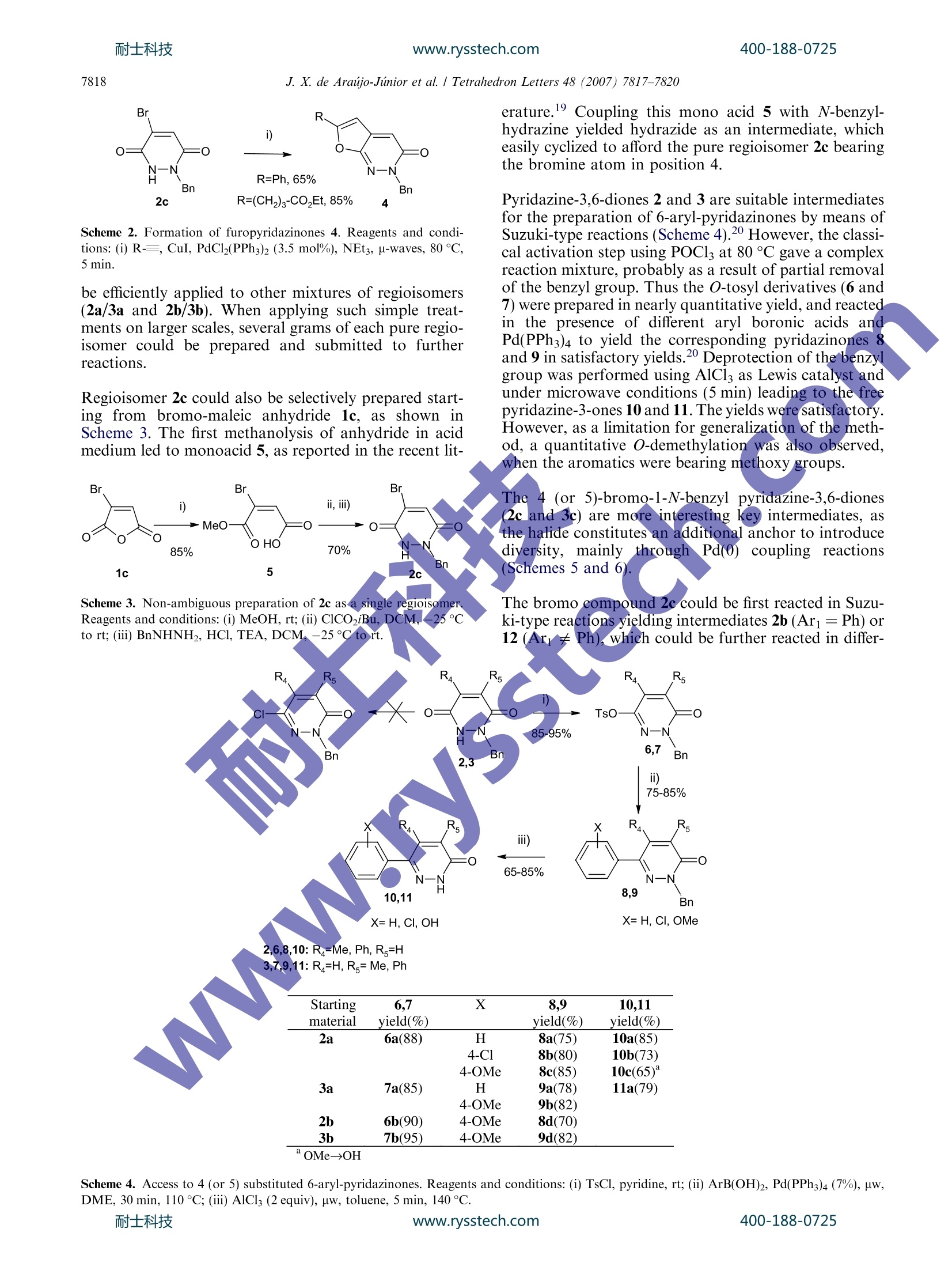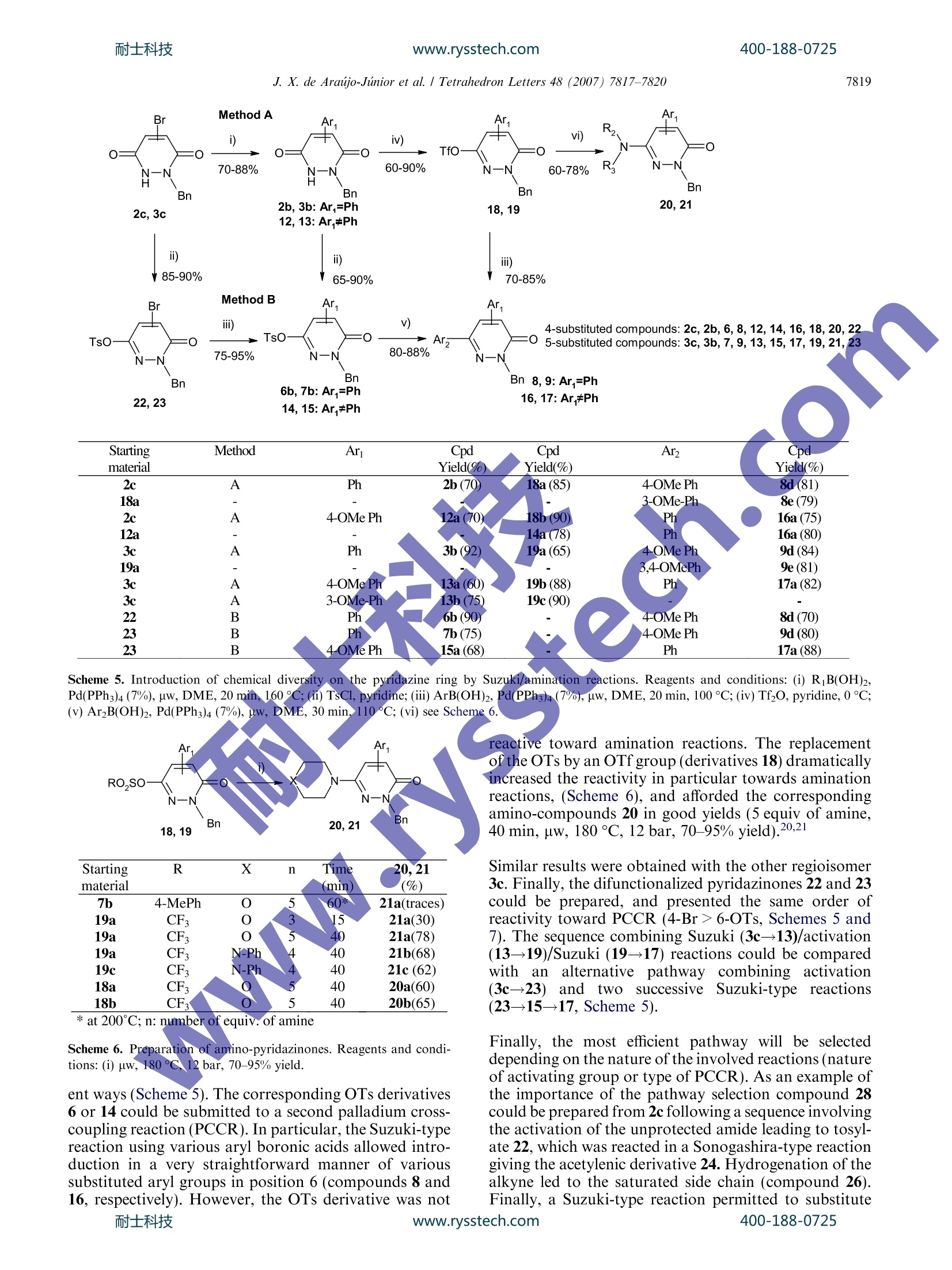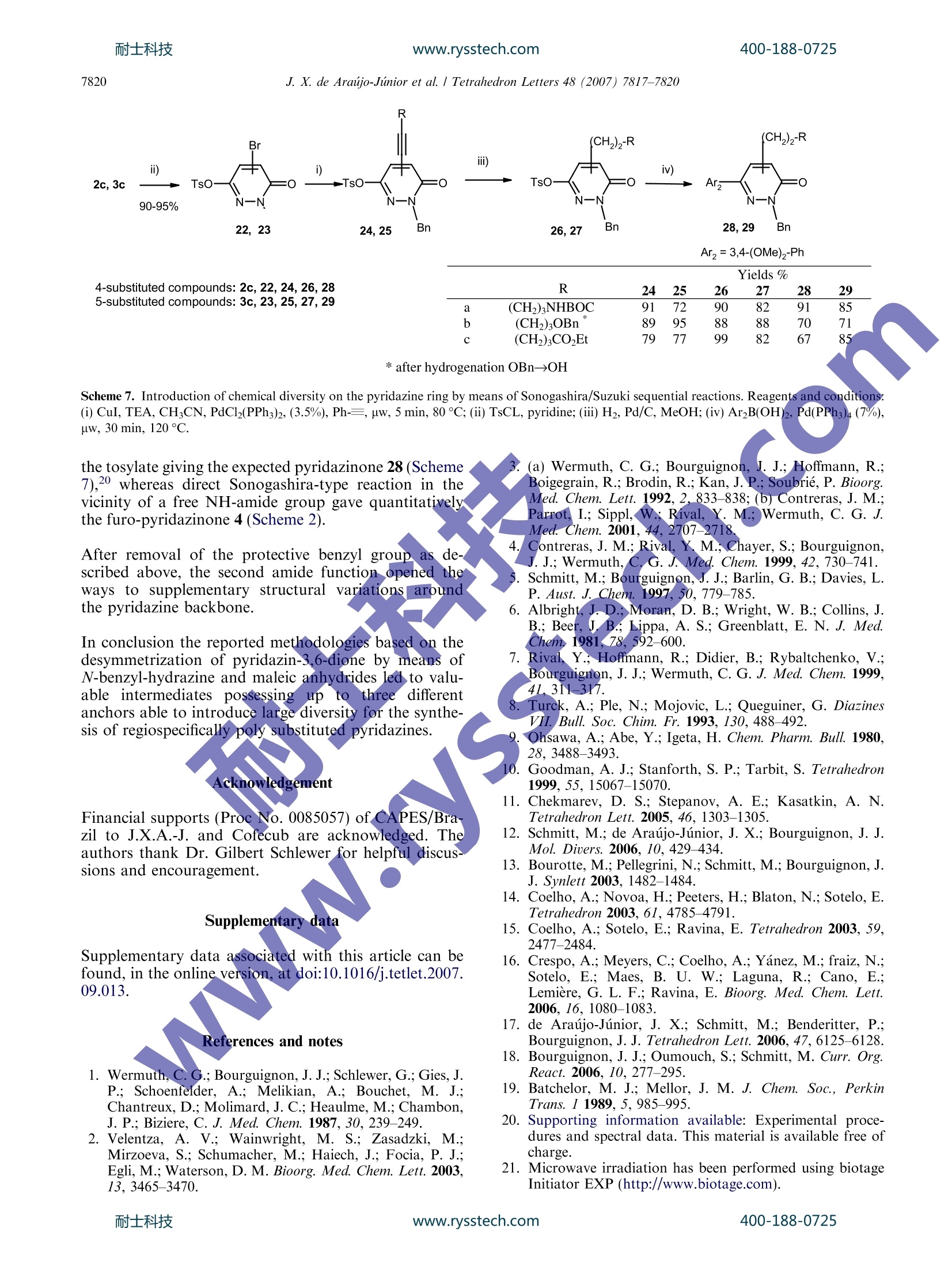
方案详情
文
Abstract—Desymmetrization of pyridazine-3,6-diones by the use of N-benzyl protective groups leads to useful starting materials for building polysubstituted pyridazine libraries in a regioselective manner.
方案详情

www.rysstech.comAvailable online at www.sciencedirect.com耐士科技400-188-0725ScienceDirectTetrahedronLettersTetrahedron Letters 48 (2007) 7817-7820 耐士科技400-188-0725www.rysstech.com7818 Synthesis of regiospecifically polysubstituted pyridazinones Joao X. de Araujo-Júnior,a, Martine Schmitt,a,* Cyril Antheaumea,and Jean-Jacques Bourguignon" aInstitut Gilbert Laustriat,UMR 7175, 74 route du Rhin, BP 60024, 67401 Illkirch, France Service Commun de RMN, Faculte de Pharmacie, 74 route du Rhin, BP 60024, 67401 Illkirch, FranceEscola de Enfermagem e Farmacia, Instituto de Quimica e Biotecnologia, Universidade Federal de Alagoas,cidade Universitaria, 57.072-970 Maceio-AL, Brazil Received 11 June 2007; revised 3 August 2007; accepted 4 September 2007Available online 6 September 2007 mo Abstract-Desymmetrization of pyridazine-3,6-diones by the use of N--benzylprotective groups leads to useful starting materials forbuilding polysubstituted pyridazine libraries in a regioselective manner.@ 2007 Elsevier Ltd. All rights reserved. Pyridazine derivatives, in particular pyridazinones, pres-enttvariouspharmacologicalproperties. In、i mostcases, the compounds bear an aryl group in position 6.Some of them are also substituted in position 42 or5.1,3b They are prepared by means of classical methodol-ogies,1,3,4generally offering fair structural diversity.More recent approaches; involving palladium cross-coupling reactions were developed starting from 3,6-di--1 3chloropyridazines,8-124-bromopyridazines,13-16 or O-tosylpyridazines.17,18Howevertheystillllpresented limitedstructural variations. To control the regioselectivity of the substitution, we re-port an original method using desymmetrization of pyr-idazine-3,6-diones bya N-benzylgroup.TThesedissymmetric intermediates permit regioselective controlof chemical variations on different positions 3, 4, 5 and 6of the pyridazine backbone. Thus, the treatment of substituted maleic anhydrides 1with N-benzyl hydrazine in acidic medium (Scheme 1)gave a mixture of the expected N-benzyl pyridazine3,6-diones 2 and 3. Due to their close Re values, the regioisomers could notbe separated by column chromatography. However, a ( Keywords: N - Benzyl 4( 5 )- substituted pyridazine 3, 6 -diones amination;Palladium c ross coupling reaction; Microwave h eating; Suzuki;Sonogashira. ) ( "Corresponding author. Tel.: + 3 3 390 244231; fa x : +3 3 39 0 244310;e-mail: sch m i t t@pharma.u-strasbg.fr ) a) total recovery of 2 and 3 after purification by recrystallization, b) 2/3ratio characterized by HNMR in the reaction mixture, c) recovery afterrecrystallisation Scheme 1. Preparation of substituted N-benzyl-pyridazine-diones 2and 3 as pure regioisomers. Reagents and conditions: (i) BnNHNH2,HCl, H2O,reflux, 12 h. simple trituration of the crude material containing 2cand 3c (Ri=Br) with a mixture ofethyl acetate and ethylether (1/4) gave an insoluble residue, which was recov-ered and recrystallized from ethanol, giving a pure regio-isomer 2c. The structure of isomer 2c was established as the Sono-gashira-type reaction product using phenylacetylene oraliphaticacetylene spontaneouslycyclizedyieldingfuro-pyridazones 4 (Scheme 2).17,20 The filtrate was recrystallized from isopropyl etheraffording the other isomer 3c. Similar treatments could 0040-4039/$- see front matter @ 2007 Elsevier Ltd. All rights reserved.doi:10.1016/j.tetlet.2007.09.013 J. X. de Araujo-Júnior et al./ Tetrahedron Letters 48 (2007)7817-7820 Scheme 2. Formation of furopyridazinones 4. Reagents and condi-tions: (i) R-=, CuI, PdCl2(PPh3)2 (3.5 mol%), NEt3, u-waves, 80°C,5 min. be efficiently applied to other mixtures of regioisomers(2a/3a and 2b/3b). When applying such simple treat-ments on larger scales, several grams ofeach pure regio-isomer could be prepared and submitted to furtherreactions. Regioisomer 2c could also be selectively prepared start-ing from bromo-maleic anhydride 1c, as shown inScheme 3. The first methanolysis of anhydride in acidmedium led to monoacid 5, as reported in the recent lit- erature.19Coupling this mono acid 5 with N-benzyl-hydrazine yielded hydrazide as an intermediate, whicheasily cyclized to afford the pure regioisomer 2c bearingthe bromine atom in position 4. Pyridazine-3,6-diones 2 and 3 are suitable intermediatesfor the preparation of 6-aryl-pyridazinones by means ofSuzuki-type reactions (Scheme 4).20 However, the classi-cal activation step using POCl at 80℃ gave a complexreaction mixture, probably as a result of partial removalof the benzyl group. Thus the O-tosyl derivatives (6 and7) were prepared in nearly quantitative yield, and reactedin the presence of different aryl boronic acids andPd(PPh3)4 to yield the corresponding pyridazinones 8and 9 in satisfactory yields.20 Deprotection of the benzylgroup was performed using AlCls as Lewis catalyst andunder microwave conditions (5 min) leading to the freepyridazine-3-ones 10 and 11. The yields were satisfactory.However, as a limitation for generalization of the meth-od, a quantitative O-demethylation was also observed,when the aromatics were bearing methoxy groups. Thee 4 (or 5)-bromo-1-N-benzyl pyridazine-3,6-diones2c and 3c) are more interestingk( intermediates, asthe halide constitutes an additional anchor to introducediversity, mainly throughFPd(0)))coupling reactions(Schemes 5 and 6). Scheme 3.Non-ambiguous preparation of 2c as a single regioisomer.Reagents and conditions: (i) MeOH, rt; (ii) CICOziBu, DCM,-25°Cto rt;(iii) BnNHNH2, HCI, TEA, DCM, -25°C to rt The bromo compound 2c could be first reacted in Suzu-ki-type reactions yielding intermediates 2b (Ar=Ph) or12(Ar Ph)1., which could be further reacted in differ- Scheme 4. Access to 4 (or 5) substituted 6-aryl-pyridazinones. Reagents and conditions: (i) TsCl, pyridine, rt; (ii) ArB(OH)2, Pd(PPh3)4 (7%), uw,DME, 30 min, 110 ℃; (iii) AlCl (2 equiv), uw, toluene, 5 min, 140°C. 2c, 3c 12, 13: Ar,Ph ii) ii) iii) V 85-90% 65-90% 70-85% Method B Br Ar. Ar. iii) v) 4-substituted compounds: 2c, 2b, 6, 8, 12, 14, 16,18,20,22 TsO- TsO- ) -= Ar, =05-substituted compounds: 3c,3b,7,9, 13, 15, 17,19,21,23 N-N 75-95% N-N 80-88% N-N Bn Bn Bn 8,9: Ar,=Ph 6b,7b: Ar=Ph 22, 23 16, 17: Ar,+Ph 14, 15: Ar#Ph Starting Method Ar Cpd Cpd Ar2 Cpd material Yield(%) Yield(%) Yield(%) 2c APh 2b (70 18a(85) 4-OMe Ph 8d(81)-A AA 18a 3-OMe-Ph 8e(79) 2c 4-OMe Ph 12a(70) 18b(90) 16a(75) 12a 14a(78) 16a(80) 3c Ph 3b(92) 19a(65) 4-0Me Ph 9d (84) 19a 3,4-OMePh 9e(81) 34-0Me Ph 13a(60) 19b (88) Ph 17a (82)2 A 3-OMe-Ph 13b (75) 19c (90) 6b(90) 4-0Me Ph 8d (70)B B 7b (75) 4-OMe Ph 9d(80) 4-OMe Ph 15a(68) Ph 17a (88) Scheme 5. Introduction of chemical diversity on the pyridazine ring by Suzuki/amination reactions. Reagents and conditions: (i) RB(OH)2,Pd(PPh3)4 (7%), uw, DME, 20 min, 160°C; (ii) TsCl, pyridine; (iii) ArB(OH)2, Pd(PPh3)4(7%), w, DME, 20 min, 100°C; (iv) TfzO, pyridine,0 C;(v) Ar2B(OH)2, Pd(PPh3)4(7%), pw, DME, 30 min, 110°C; (vi) see Scheme 6. Starting n Time 20,21 material (min) (%) 7b 4-MePh .5 21a(traces) 19a CF3 3 21a(30) 19a CF 21a(78) 19a X-Ph 4 21b(68) 19c Ph 21c (62) 18a 20a(60) 18b CF 5 20b(65) * at 200℃; n: number of equiv. of amine Scheme 6. Preparation of amino-pyridazinones. Reagents and condi-tions: (i) uw, 180℃, 12 bar, 70-95% yield. ent ways (Scheme 5). The corresponding OTs derivatives6 or 14 could be submitted to a second palladium cross-coupling reaction (PCCR). In particular, the Suzuki-typereaction using various aryl boronic acids allowed intro-duction in a very straightforward manner of varioussubstituted aryl groups in position 6 (compounds 8 and16,respectively). However, the OTs derivative was not reactive toward amination reactions. The replacementof the OTs by an OTf group (derivatives 18) dramaticallyincreased the reactivity in particular towards aminationreactions, (Scheme 6), and afforded the correspondingamino-compounds 20 in good yields (5 equiv of amine,40 min, uw, 180°℃, 12 bar, 70-95% yield).20,21 Similar results were obtained with the other regioisomer3c. Finally, the difunctionalized pyridazinones 22 and 23could be prepared, and presented the same order ofreactivity toward PCCR (4-Br>6-OTs, Schemes 5 and7). The sequence combining Suzuki (3c→13)/activation(13→19)/Suzuki (19→17) reactions could be comparedwithanalternativepathway combining activation(3c→23)and two successiveSuzuki-type reactions(23→15→17, Scheme 5). Finally, the most efficient pathway will be selecteddepending on the nature of the involved reactions (natureof activating group or type of PCCR). As an example ofthe importance of the pathway selection compound 28could be prepared from 2c following a sequence involvingthe activation of the unprotected amide leading to tosyl-ate 22, which was reacted in a Sonogashira-type reactiongiving the acetylenic derivative 24. Hydrogenation of thealkyne led to the saturated side chain (compound 26).Finally, a Suzuki-type reaction permitted to substitute Scheme 7. Introduction of chemical diversity on the pyridazine ring by means of Sonogashira/Suzuki sequential reactions. Reagents and conditions:(i) CuI, TEA, CH,CN, PdCl2(PPh3)2,(3.5%), Ph-=, uw, 5 min, 80°℃; (ii) TsCL, pyridine; (iii) H2, Pd/C, MeOH; (iv) Ar2B(OH)2, Pd(PPh)4 (7%),uw, 30 min, 120°C. the tosylate giving the expected pyridazinone 28 (Scheme7),20 whereas direct Sonogashira-type reaction in thevicinity of a free NH-amide group gave quantitativelythe furo-pyridazinone 4 (Scheme 2). After removal of the protective benzyl group asdescribed above, the second amide function openedtheways to supplementary structural variations aroundthe pyridazine backbone. In conclusion the reported methodologies based on thedesymmetrization of pyridazin-3,6-dione by means ofN-benzyl-hydrazine and maleic anhydrides led to valu-able intermediates possessingup to three differentanchors able to introduce large diversity for the synthe-sis of regiospecifically poly substituted pyridazines. Financial supports (Proc No. 0085057) of CAPES/Bra1-zil to J.X.A.-J. and Cofecub are acknowledged. Theauthors thank Dr.Gilbert Schlewer for helpful discus-sions and encouragement. Supplementary data Supplementary data associated with this article can befound, in the online version, at doi:10.1016/j.tetlet.2007. 1. Wermuth, C. G.; Bourguignon,J. J.;Schlewer, G.; Gies, J.P.; Schoenfelder, A.; Melikian, A.; Bouchet, M. J.;Chantreux, D.; Molimard, J. C.; Heaulme, M.;Chambon,J.P.;Biziere, C. J. Med. Chem. 1987, 30, 239-249. 2. IVelentza, A. V.; Wainwright, M. S.; Zasadzki, M.Mirzoeva, S.; Schumacher, M.; Haiech, J.; Focia, P. J.;Egli, M.; Waterson, D. M. Bioorg. Med. Chem. Lett. 2003,13,3465-3470. (a) Wermuth, C. G.; Bourguignon,J. J.; Hoffmann, R.;Boigegrain, R.; Brodin, R.; Kan, J. P.; Soubrie, P. Bioorg.Med. Chem. Lett. 1992, 2,833-838; (b) Contreras, J. M.;Parrot, I.; Sippl,,W.: Rival, Y. M.;; WVermuth, C. G. J.Med. Chem. 2001, 44,2707-2718. 4.Contreras, J.M.; Rival, Y. M., Chayer, S.; Bourguignon,J. J.; Wermuth, G.J. Med. Chem. 1999,42, 730-741.I. Schmitt, M.; Bourguignon, J. J.; Barlin, G. B.; Davies, L.P. Aust.J. Chem. 1997,50, 779-785. Albright, J.D.;Moran, D. B.; Wright, W. B.; Collins, J.B.; Beer, J. B., Lippa, A. S.; Greenblatt, E. N. J. Med.Chem. 19811,78,,5592-600. 7.. Rival,Y.; Hoffmann, R.; Didier, B.; Rybaltchenko, V.;Bourguignon, J. J.; Wermuth, C. G. J. Med. Chem. 1999,41. 311-317. 8.Turck, A.; Ple, N.; Mojovic, L.; Queguiner, G. DiazinesVII.Bull. Soc. Chim. Fr. 1993,130,488-492. Ohsawa, A.; Abe, Y.; Igeta, H. Chem. Pharm. Bull. 1980,28,3488-3493. 10.(Goodman, A. J.;Stanforth, S. P.; Tarbit,S. Tetrahedron1999,55,15067-15070. 11. Chekmarev, D. S.; Stepanov, A. E.; Kasatkin, A. N.Tetrahedron Lett. 2005, 46,1303-1305. 12. SSc(hmitt, M.; de Araujo-Júnior, J. X.; Bourguignon, J. J.Mol. Divers. 2006,10, 429-434. 13. Bourotte,M.; Pellegrini, N.; Schmitt, M.; Bourguignon, J.J. Synlett 2003, 1482-1484. 14.C oCelho, A.; Novoa, H.; Peeters, H.; Blaton, N.; Sotelo, E.Tetrahedron 2003,61,4785-4791. Coelho, A.; Sotelo, E.; Ravina, E. Tetrahedron 2003, 59,2477-2484. 16. Crespo, A.; Meyers, C.; Coelho, A.; Yánez, M.;fraiz, N.;Sotelo, E.; Maes, B. U. W.; Laguna, R.; Cano, E.;Lemiere, G. L. F.; Ravina, E. Bioorg. Med. Chem. Lett.2006, 16,1080-1083. 17. de Araujo-Júnior, J. X.; Schmitt, M.; Benderitter, P.;Bourguignon, J. J. Tetrahedron Lett. 2006, 47,6125-6128. 18.Bourguignon, J. J.;Oumouch, S.;Schmitt, M. Curr. Org.React. 2006,10,277-295. 19. Batchelor, M. J.; Mellor, J. M. J. Chem. Soc., PerkinTrans. 1 1989, 5,985-995. 20. Supporting information available: Experimental proce-dures and spectral data. This material is available free ofcharge. 21.M]icrowave irradiation has been performed using biotageInitiator EXP (http://www.biotage.com). ww.rysstech.com耐士科技 ww.rysstech.com耐士科技
确定




还剩2页未读,是否继续阅读?
上海鑫欣生物科技有限公司为您提供《化学药中特殊物质和基团检测方案 》,该方案主要用于化药新药研发中其他检测,参考标准--,《化学药中特殊物质和基团检测方案 》用到的仪器有
相关方案
更多
该厂商其他方案
更多








